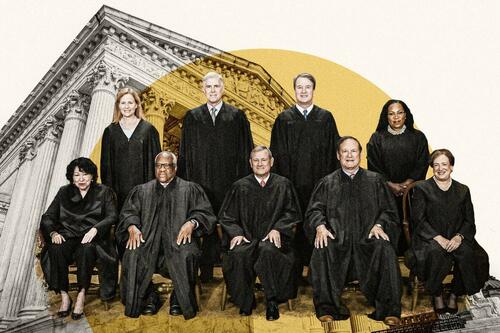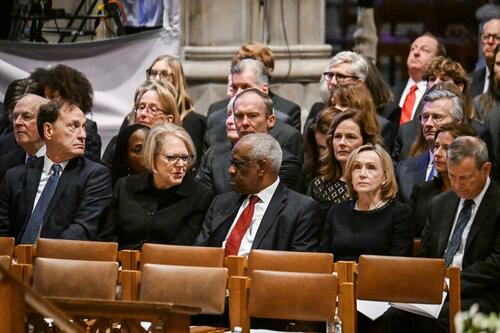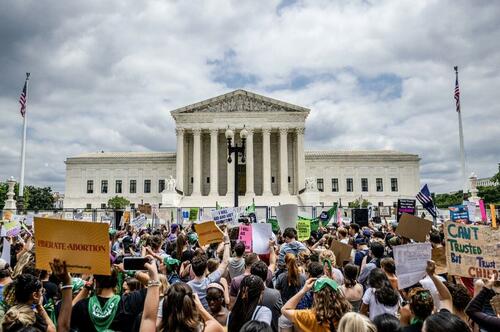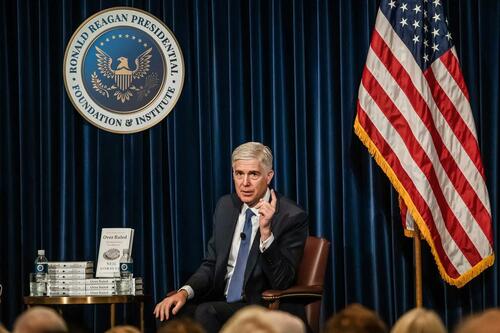Authored by Sam Dorman via The Epoch Times,
President-elect Donald Trump’s second term could help make him one of the most consequential presidents for the U.S. Supreme Court by solidifying a long-lasting originalist majority.
Although Democrats have criticized the justices in recent months, the 2024 elections may have stripped them of the power they would need to block Trump’s nominees and implement reforms to stunt conservatives’ influence on the court.
Republicans are projected to take the U.S. Senate, offering a two-year window for Trump to appoint new conservative jurists to the highest court should any of the sitting justices announce retirement. Neither of the two most senior justices, Clarence Thomas, who is 76 and joined the court in 1991, and Samuel Alito, who is 74 and joined in 2006, have announced a retirement plan.
“No one other than Justices Thomas and Alito knows when or if they will retire, and talking about them like meat that has reached its expiration date is unwise, uninformed, and, frankly, just crass,” Federalist Society chairman Leonard Leo said.
If Trump is later tasked with appointing two justices, he could be the first president since President Dwight D. Eisenhower to have five of his nominees sit on the nation’s highest court.
In terms of pace, Trump has already appointed more justices in one term than his predecessors did during their tenures. Continuing at that pace would likely lead to long-term shifts for the institution and its jurisprudence, especially if his successors follow other presidents in nominating fewer justices.
Changes to Precedent
The court, led by Chief Justice John Roberts, has been described as incrementalist, but some of its recent decisions have raised questions about the stability of longstanding precedents. Trump’s nominees—Justices Neil Gorsuch, Brett Kavanaugh, and Amy Coney Barrett—have already contributed to major shifts in American law, starting with their vote to overturn Roe v. Wade in 2022.
Just before Trump’s reelection, they also redefined the scope of presidential immunity and overruled a decades-old administrative law doctrine—known as Chevron deference—that was supported by the late Justice Antonin Scalia.
Conservatives have touted this decision and Dobbs as following an originalist approach, or one that seeks to follow the Constitution’s original meaning. Such an approach might continue if Trump selects justices from the long list of judges appointed to federal courts during his first term in office.
(Front Row R–L) Supreme Court Chief Justice John Roberts, his wife Jane Sullivan, Supreme Court Associate Justice Clarence Thomas, his wife, Virginia Thomas, and Supreme Court Associate Justice Samuel Alito attend the memorial service for former U.S. Supreme Court Justice Sandra Day O'Connor at the National Cathedral in Washington on Dec. 19, 2023. Jim Watson/POOL/AFP via Getty Images
Judicial Crisis Network President Carrie Severino told The Epoch Times that if Trump wanted to appoint more originalists to the Supreme Court, he wouldn’t have to “look any farther than the appellate judges” he appointed during his first term.
“If he picks from that short list he himself has created, then I think we’re going to have an awesome continuation of the originalist approach to the Constitution,” said Severino, a former Thomas clerk.
In October, a three-judge appellate panel, which included a former Thomas clerk and former Alito clerk, backed Republicans’ position that election officials couldn’t count ballots that arrived after voting day. They said doing so violated the Constitution and a law passed in 1844 on the timing of elections.
Thomas has said on more than one occasion that he has no intention of retiring. Meanwhile, conservative attorney and commentator Ed Whelan has speculated in National Review that Alito will retire next spring with Thomas following him in 2026.
Civil Liberties
The Supreme Court’s recent decisions have been viewed by both sides of the ideological spectrum as utilizing originalism and textualism, or trying to adhere to the plain language of American laws, after decades of different approaches.
“After most of the 20th Century spent with a very liberal court, we actually have a majority of originalists in the court,” Severino said during a press call this summer.
Overturning Roe raised questions about a whole body of law, known as “substantive due process,” which stems from the 14th Amendment’s due process clause.
That body of law informed the court’s decision in a series of other cases like Griswold v. Connecticut, Lawrence v. Texas, and Obergefell v. Hodges, which struck down state laws on birth control, sodomy, and marriage respectively. Following Dobbs, left-leaning voices worried that the more conservative Supreme Court would eventually overturn those cases.
People protest in response to the Dobbs v. Jackson Women's Health Organization ruling in front of the U.S. Supreme Court in Washington on June 24, 2022. The Court's decision overturns the landmark 50-year-old Roe v Wade case. Brandon Bell/Getty Images
Alito’s majority opinion in Dobbs v. Jackson Women’s Health, which overturned Roe, indicated that the idea of a constitutional right to abortion exceeded the bounds of substantive due process. However, he attempted to distinguish it from the issues in Lawrence and other cases while maintaining that his opinion wouldn’t threaten those other precedents.
Thomas’s concurring opinion went further in describing substantive due process as “an oxymoron” and said the court should “reconsider all of this Court’s substantive due process precedents, including Griswold, Lawrence, and Obergefell.”
Former federal prosecutor Neama Rahmani told The Epoch Times, “We may see the justices continue to chip away at civil rights and substantive due process.”
Rahmani pointed to Dobbs and the court’s ruling in 2023 that Harvard University’s and the University of North Carolina’s affirmative action programs violated the equal protection clause. The court’s Obergefell decision and its 1966 decision in Miranda v. Arizona—which established the Miranda warning that police read to suspects to remind them of their rights during criminal proceedings—may be up for grabs too, Rahmani said.
A ‘MAGA Supreme Court’?
Based on decisions by Trump’s already-appointed justices, it’s questionable whether a court transformed by the president-elect would deliver consistent wins for conservatives’ political causes.
Some of the court’s recent decisions have prompted Democrats to describe the justices as part of a “MAGA Supreme Court”—a reference to Trump’s “Make America Great Again” slogan.
Like others, the American Civil Liberties Union (ACLU) criticized the court’s immunity decision, which granted presidents various levels of immunity from criminal prosecution. “On purely partisan lines, the Supreme Court today for the first time in history places presidents substantially above the law,” ACLU National Legal Director David Cole said in July.
Besides its rulings on immunity and abortion, the court ruled in favor of gun rights advocates this year by effectively allowing bump stocks, and in 2022, by clarifying that firearm restrictions must follow the nation’s history and tradition.
Trump himself has praised the justices but expressed disagreement as well, such as when he said the court “really let us down” after it declined to take up a 2020 election-related case from Texas. He also publicly clashed with Roberts, who said in 2018: “We do not have Obama judges or Trump judges, Bush judges or Clinton judges.”
Illustrating the tenuous ideological formations, Roberts wrote a concurrence that sought to maintain but weaken Roe. Neither Barrett nor Kavanaugh joined that opinion and have each voted differently than both Alito and Thomas on important cases. According to Empirical SCOTUS, Barrett’s, Kavanaugh’s, and Roberts’ votes aligned most with each other’s when compared with the other justices.
Barrett joined the immunity decision in Trump v. United States but partly differed in a way that Roberts said “threatens to eviscerate the immunity we have recognized.” She also joined liberals on the court in ruling against Jan. 6 defendants, as well as in resisting the avenue other justices took in ruling that Colorado couldn’t disqualify Trump from appearing on its ballot this year.
Former President Donald Trump, the Republican 2024 presidential candidate, arrives back at Trump Tower after being convicted in a criminal trial in New York City on May 30, 2024. Timothy A. Clary/AFP via Getty Images
In another ruling on agency power this year, Barrett joined Thomas, Roberts, Sotomayor, Kagan, Kavanaugh and Jackson to uphold the Consumer Financial Protection Bureau’s controversial funding mechanism, which right-leaning advocates saw as unconstitutional. Only Alito and Gorsuch dissented from that decision.
Overruling Chevron could interfere with Trump’s deregulatory agenda as well, even though it’s been backed by critics of administrative overreach. The doctrine was initially decided in 1984 by the majority led by Justice John Paul Stevens and it upheld a deregulatory action by President Ronald Reagan’s administration. Overruling it gave judges more power in reviewing agencies’ interpretations of existing law.
Evolving Originalism
Besides demonstrating an interest in economic deregulation, Trump also said that his second term would see regulations related to gender—specifically opposing so-called “gender-affirming care” for minors. Those regulations will likely encounter lawsuits with left-leaning groups citing Gorsuch’s controversial majority opinion in Bostock v. Clayton County.
Gorsuch, whose voting aligned most with Thomas’s last term, joined Roberts in ruling that firing someone on the basis of sexual orientation or gender identity was a form of sex-based discrimination because the actions wouldn’t have been made “but for” the individuals’ sex.
That reasoning has been used by lower courts to support so-called left-leaning interest on the issue of gender, including the idea that states can’t exclude adults from receiving transgender procedures under government insurance programs.
President Joe Biden’s administration is currently using Gorsuch’s reasoning in asking the Supreme Court to strike down Tennessee’s law banning so-called “gender-affirming care” for minors. U.S. Solicitor General Elizabeth Prelogar argued that Bostock’s “core insight is that ‘it is impossible to discriminate against a person for being ... transgender without discriminating against that individual based on sex.’”
What originalism and textualism mean in practice may be evolving due at least in part to the influence of Trump-appointed justices. In his dissent, Alito said “no one should be fooled” by Gorsuch’s “attempts to pass off its decision as the inevitable product of the textualist school of statutory interpretation.”
Supreme Court Associate Justice Neil Gorsuch speaks at the Reagan Library in Simi Valley, Calif., on Aug. 8, 2024. Apu Gomes/Getty Images
Thomas’s approach to originalism has encountered resistance among many on the court. He was the only justice to say in June that his originalist opinion in Bruen protected domestic abusers’ ability to own firearms.
That case—U.S. v. Rahimi—spurred a relatively high number of concurrences from Barrett, Kavanaugh, Gorsuch, and Sotomayor each disputing how to apply the nation’s history when considering firearm regulations.
Another decision rejecting a crude, Trump-related trademark saw the justices similarly differing over how to apply legal history despite each agreeing with the ultimate outcome of the case.
In a concurrence joined by liberal-leaning justices, Barrett said Thomas’s approach was “wrong twice over” and suggested that it overemphasized the role of historical comparison. Thomas had argued that a “firm grounding in traditional trademark law is sufficient to justify the content-based trademark restriction here.”




